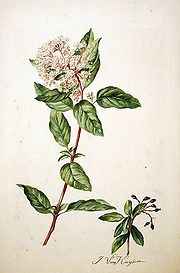
Jacob van Huysum
Encyclopedia


Both his father Justus van Huysum
Justus van Huysum
Justus van Huysum, also spelled Huijsum, was a Dutch Golden Age painter.-Biography:He was the son of the decorative painter Jan van Huysum I and the brother of the engraver Caspar van Huysum...
(1659–1716), and his brother Jan van Huysum
Jan van Huysum
Jan van Huysum, also spelled Huijsum, was a Dutch painter.-Biography:He was the brother of Jacob van Huysum, the son of the flower painter Justus van Huysum, and the grandson of Jan van Huysum I, who is said to have been expeditious in decorating doorways, screens and vases...
(1682–1749), were celebrated flower painters. His manner of painting was very like that of his brother. His approach to botanical illustration, while preserving botanical accuracy, captured a more painterly aspect of his subject. This contrasts with the meticulously exact mode of Georg Dionysius Ehret
Georg Dionysius Ehret
Georg Dionysius Ehret was a botanist and entomologist, and is best known for his botanical illustrations.Ehret was born in Germany to Ferdinand Christian Ehret, a gardener and competent draughtsman, and Anna Maria Ehret. Beginning his working life as a gardener's apprentice near Heidelberg, he...
, his contemporary colleague.
Jacob arrived in England in about 1721, and for a while lived in the house of his patron, Mr. Lockyear of South Sea House. Later he enjoyed the patronage of Sir Robert Walpole
Robert Walpole
Robert Walpole, 1st Earl of Orford, KG, KB, PC , known before 1742 as Sir Robert Walpole, was a British statesman who is generally regarded as having been the first Prime Minister of Great Britain....
, who befriended him, and commissioned him to paint decorative works for his house at Houghton
Houghton
-Buildings:* Houghton Hall, a country house in Norfolk, England * Houghton Hall, East Riding of Yorkshire, a stately home in Yorkshire, England* Houghton House, a ruined house in Bedfordshire, England-Australia:...
in Norfolk
Norfolk
Norfolk is a low-lying county in the East of England. It has borders with Lincolnshire to the west, Cambridgeshire to the west and southwest and Suffolk to the south. Its northern and eastern boundaries are the North Sea coast and to the north-west the county is bordered by The Wash. The county...
. More importantly he produced most of the 50 illustrations for John Martyn's
John Martyn (botanist)
John Martyn or Joannis Martyn was an English botanist.Martyn's is best known for his Historia Plantarum Rariorum , and his translation, with valuable agricultural and botanical notes, of the Eclogues and Georgics of Virgil...
Historia Plantarum Rariorum (London: 1728-38), and all the drawings for Catalogus Plantarum, an index of trees, shrubs, plants and flowers (London: 1730).
Historia Plantarum Rariorum depicted plants from the Chelsea Physic Garden
Chelsea Physic Garden
The Chelsea Physic Garden was established as the Apothecaries’ Garden in London, England in 1673. It is the second oldest botanical garden in Britain, after the University of Oxford Botanic Garden, which was founded in 1621.Its rock garden is the oldest English garden devoted to alpine plants...
and the Cambridge Botanic Garden. These plants had come from the Cape of Good Hope
Cape of Good Hope
The Cape of Good Hope is a rocky headland on the Atlantic coast of the Cape Peninsula, South Africa.There is a misconception that the Cape of Good Hope is the southern tip of Africa, because it was once believed to be the dividing point between the Atlantic and Indian Oceans. In fact, the...
, North America
North America
North America is a continent wholly within the Northern Hemisphere and almost wholly within the Western Hemisphere. It is also considered a northern subcontinent of the Americas...
, the West Indies, and Mexico
Mexico
The United Mexican States , commonly known as Mexico , is a federal constitutional republic in North America. It is bordered on the north by the United States; on the south and west by the Pacific Ocean; on the southeast by Guatemala, Belize, and the Caribbean Sea; and on the east by the Gulf of...
. Elisha Kirkall produced the mezzotint engravings. Each plate was dedicated to a patron and showed an engraved coat-of-arms or monogram. Besides van Huysum, other artists were William Houstoun
William Houstoun (botanist)
William Houstoun was a Scottish surgeon and botanist who retrieved plants from Mexico and South America.He was born in Houston, Renfrewshire. He began a degree course in medicine at St Andrew's University but completed his medical training at the University of Leiden in the Netherlands in 1729...
, Massey, G. Sartorys, and R. Sartorius. The work was published in five parts of ten plates each between 1728 and 1737, and was sold by subscription. The venture was not a financial success and publication ceased in 1737.

